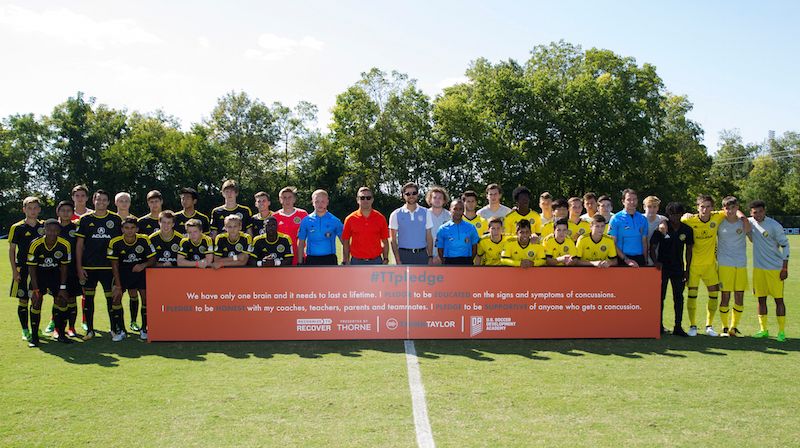I pledge to be educated on the signs and symptoms of concussions.
I pledge to be honest with my coaches, teachers, parents and teammates.
I pledge to be supportive of anyone who gets a concussion.
The ThinkTaylor pledge encapsulates the goals of Concussion Awareness Week. It’s not just about the recognition of traumatic head injuries, it’s about building a culture.
“We’re all advocating for player safety,” said Dr. George Chiampas, U.S. Soccer Chief Medical Officer. “The game of soccer is probably one of the best outlets for youth sports. It’s our responsibility as a federation to make sure that we can put all the parameters around it to keep it safe. That is by first and foremost, building a culture. It’s ok to come out of a game. It’s ok to take a step back and put the most important priorities first.”
U.S. Soccer, Recognize to Recover, presented by Thorne and ThinkTaylor will partner from Sept. 1-11 for Concussion Awareness Week. As millions of players, coaches and referees kick off their seasons across the country, constructing this reformed culture around concussions will be top of mind.
While it’s just the second annual Concussion Awareness Week, U.S. Soccer has long been a leader in player safety. Proper concussion protocols have always stood as a critical responsibility in the National Team set-up. Last year, the first Concussion Awareness Week brought those standards to the country’s highest level of youth soccer, the U.S. Soccer Development Academy. Now, the program will reach out to everyone involved with the Federation nationwide. In addition to outreach through U.S. Soccer member organizations, Concussion Awareness Week will feature during upcoming friendlies for the U.S. Men’s and Women’s National Teams.
“Taking the standards from our National Team environment and bringing them to everyone is the goal,” Chiampas said. “It’s always been a pivotal piece there and we want to disseminate the most accurate and quality information across the four million youth players, coaches and referees so that we can say broadly we’re trying to build a culture of safety.”
Part of that nationwide reach comes in the newly-released grassroots coaching courses. Made available online at the Digital Coaching Center on Aug. 23, each level includes a 30-minute video module on player safety, featuring concussion protocol, cardiac arrest, heat guidelines and more. A similar program will be rolled out in referee licensure programs in the near future.
“Every coach and eventually every referee that is licensed in the U.S. will go through this module. We are really excited about this platform,” Chiampas said. “We can now say broadly across the country, regardless of what state your child plays in, that every coach has taken this safety module. By that mechanism, we’re leaders with regards to soccer safety in the United States and hopefully in the world.”
While every coach and referee across the country will eventually have gone through the player safety module, the ThinkTaylor pledge helps players contribute directly to a more effective concussion awareness culture. U.S. Soccer first partnered with ThinkTaylor last fall, as the Development Academy’s 17,000 players were encouraged to take the pledge. This year, the pledge will reach millions more across the country through U.S. Soccer member programs like AYSO, U.S. Youth Soccer and U.S. Club Soccer.
ThinkTaylor is the passion project of former U.S. Men’s National Team player Taylor Twellman. Concussions cut the forward’s career short, and he launched ThinkTaylor to spread awareness of traumatic brain injuries. The pledge’s three pillars: to be educated, honest and supportive aim to bring about social change in the world of concussions.
“It’s a mechanism for us to be able to engage with our players and our coaches broadly,” Chiampas said. “They’re pledging to protect themselves, protect their teammates and protect their players in and around this injury. When you’re a player or when you’re a coach, in that moment, you may not want to come forward and say, ‘I think I’m having some of the symptoms’ because you’re in the moment of playing. As a player, it’s ok to come forward and say, ‘Hey I don’t feel right.’”
U.S. Soccer has continued to grow its concussion awareness campaigns, but the federation has consistently been a global leader in the field. In 2015, Chiampas and his staff introduced groundbreaking heading initiatives for younger players, designed to limit risk in aerial challenges, one of the game’s most dangerous situations. The directives put the focus on purposeful headers, situations where a player sees the ball, properly protects them self, gets in good position and completes the play with good form.
“A vast majority of head injuries that occur in soccer occur on aerial challenges: two players going up for a ball, hitting heads, elbow to head, shoulder to head, or head to ground,” Chiampas said. “If we protect those players, especially at a young age, and decrease incidence of those collisions, we therefore indirectly will decrease the incidence of concussions at an age that may be vulnerable.”
That same year, 2015, marked the launch of Recognize to Recover, a comprehensive player safety program. The first platform of its kind, Recognize to Recover provides a world-class resource of information to improve injury prevention and management. Now, Concussion Awareness Week will trumpet its message nationwide.
“We’re excited with where we’re at, but we also know we have a lot of work ahead of us,” Chiampas said. “We need our players, we need our parents, we need our coaches, we need our referees to engage with us, because we’re all in this together and that’s how we’ll keep our sport safe. It comes with a positive behavior, it comes with an underlying culture and attitude where player safety is first and paramount. If we can build that within our sport here in the United States, we can potentially be a precedent across the world.”

